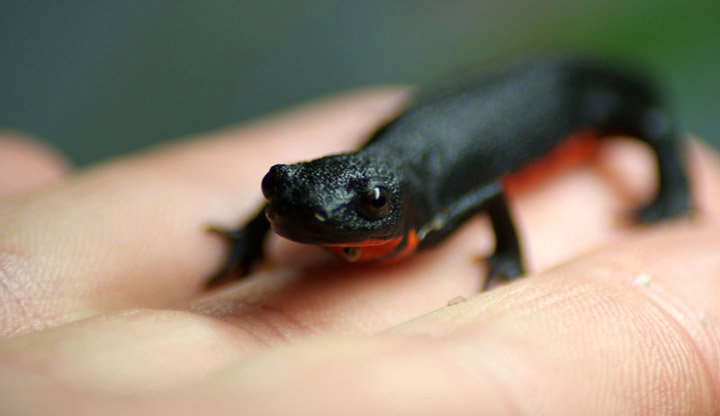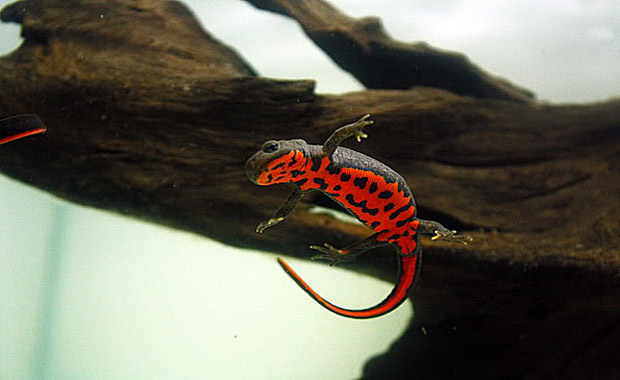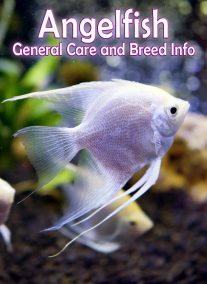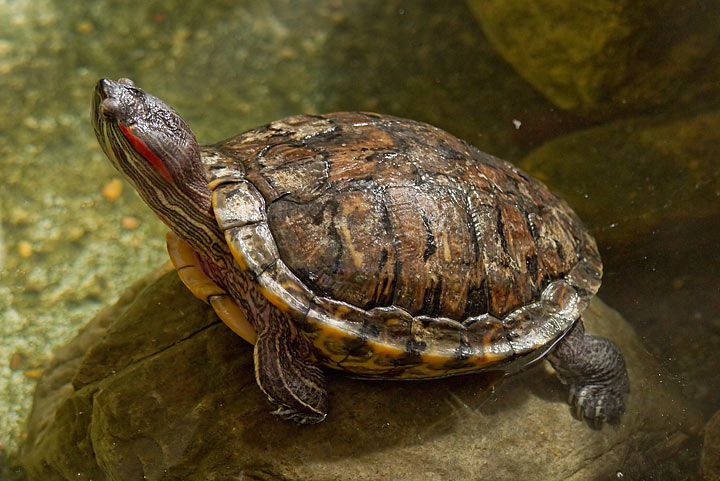
Fire bellied newts are among the most commonly available amphibians at pet shops
Appearance
Fire Bellied Newts sometimes are also called the oriental fire bellied newt, and the dwarf fire bellied newt. The other member of this family of newts that has commonly been found in the pet trade is Cynops pyrrhogaster, or the Japanese fire bellied newt.
Both of these newts are dark brown to black over most of their body, save the brightly contrasting fiery orange red markings on the belly. In the wild, these markings serve a warning to predators, for fire bellied newts produce some potent skin toxins and have fairly prominent parotid (poison) glands on the sides of their head.
There are some differences in the size and appearance of the two newts. C. Pyrrhogaster (Japanese fire bellied newt) averages about 3.5 to 5 inches (9-12 cm), although there have been reports of them reaching 6 inches (15 cm). This newt has a rough or bumpy appearance to the skin, and generally the pattern of the red/orange coloration on the belly is speckled. C. orientalis is a bit smaller at 3-4 inches (6-10 cm), and the skin appears smoother. The orange pattern on the belly tends to be more blotchy, with orange sometimes the predominant color on the belly.
The only real impact of these differences is that the larger Japanese fire bellied newt needs a little more room and can handle a bit larger prey.
Housing
Housing for fire bellied newts is not difficult to provide, but a few things should be kept in mind. In the wild these newts are largely aquatic, but they should be provided with a land area which they can climb out on to rest and bask (the occasional odd fire bellied newt will spend a fair amount of time on land). And while they don’t need a huge tank, keep in mind that the larger the volume of water they live in, the less chance of toxic waste products building up to a harmful level.
- Tank: For a few newts (3-4), a 20 gallon tank should be sufficient. The land area can be provided by sloping gravel up to one end of the tank, or sectioning off a land area with Plexiglas set in place with aquarium grade silicone. Rocks, moss, and pieces of bark can be used to make a land area with hiding places if desired. However, for the majority of newts, a floating island of wood or rocks (which should be fairly smooth to prevent damaging delicate skin on newt bellies) is sufficient for a land area. The bottom of the tank can be lined with smooth gravel, which should be large enough that the newts can not swallow it. Provide lots of plants (the live ones are nicer than plastic and easy to care for, although a fluorescent light fixture with a plant bulb should be provided).
- Filtration: Filtration should be provided, although strong currents are best avoided. Inside corner filters (the kind powered by air) work well, as they create little current. Internal power filters are also a good choice, as long as they are not too powerful and positioned so as to minimize the current produced. Under gravel filters are also a good option.
- Temperature: Fire bellied newts do best at temperatures on the cool side – they tolerate room temperature (70 F/21 C) but will be happier at slightly lower temperatures – 68 F (20 C) or a bit lower are more ideal. At temperatures around 75 F (24 C) or higher, they will be stressed and susceptible to infections, particularly fungal infections. Keeping a tank in the basement is a good way to maintain lower temperatures. Unless you have air conditioning, keeping the tank cool enough may be more of a concern than providing heat. In hot weather, placing a fan over the tank, or letting ice (made with dechlorinated water, of course) drip into the tank may be an option if your house temperature is too high for the newts.
- Water: Approximately 1/3 of the volume of water in the tank should be removed and replaced with fresh, dechlorinated water every 1-2 weeks (depending on the size of the tank and the number of newts – it should be done more often for smaller tanks and larger numbers of newts). A gravel washer is an inexpensive tool available at pet stores that allows the gravel to be gently agitated and cleaned while siphoning off water.
- Lighting: Newts should be kept on a light/dark cycle that is regular. 12 hours light/12 hours dark is probably sufficient if you are providing light, or simply allow them normal daylight in a well lit room – as long as their tank isn’t in direct sunlight. Newts do not have any requirement for special UV light fixtures, but a low watt fluorescent fixture can be used if you have live plants in the tank. Just make sure the newts have a shaded or sheltered area available in the tank.

Feeding
Depending on your newt, you may have to try a variety of food sources. Bloodworms, frozen or live, seem to a favorite among newt keepers. These (especially the frozen bloodworms) are quite readily available at pet stores. They may also eat earthworms (chopped), brine shrimp, glass shrimp, daphnia, and freeze-dried tubifex cubes. Floating reptile/amphibian sticks such as Repto-Min can also be fed, although many newts refuse them. Larger newts, particularly the larger Japanese fire bellied newt, may also eat feeder guppies if offered.
Fire bellied newts do not have to be fed every day – every other day or every three days is often enough. It may take a little experimentation to figure out how much and how often they should be fed, but you can try to judge by their growth and body condition (fat or skinny) and whether excess food is being left (which will cause toxins to build up in the tank). These newts are nice for people new to amphibians as pet because they are readily available, and don’t require a lot of specialized care.




Leave a Reply